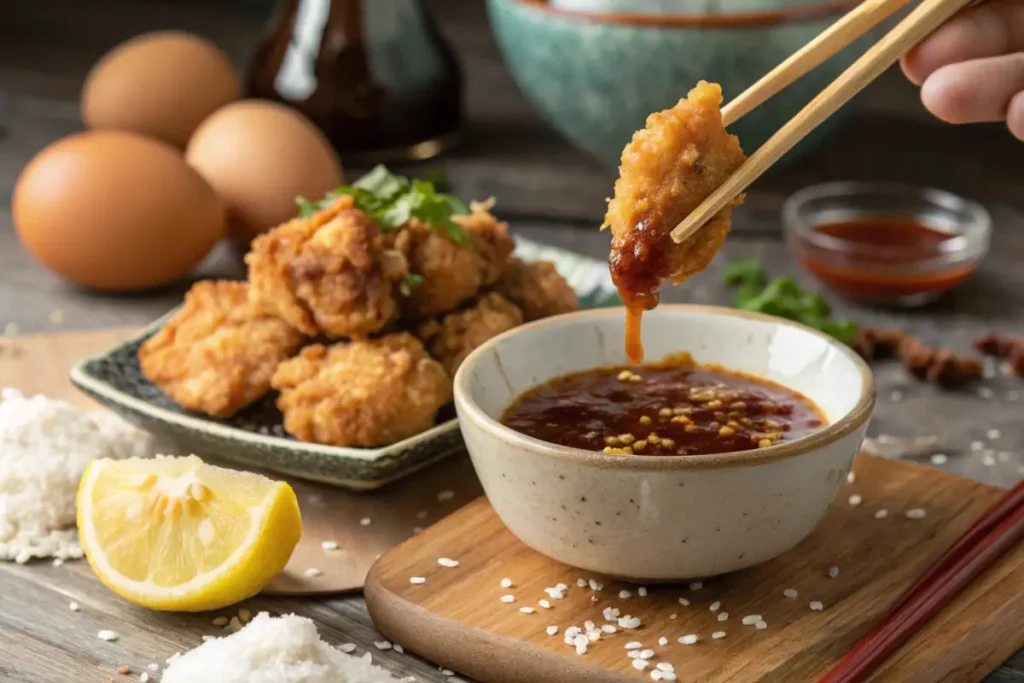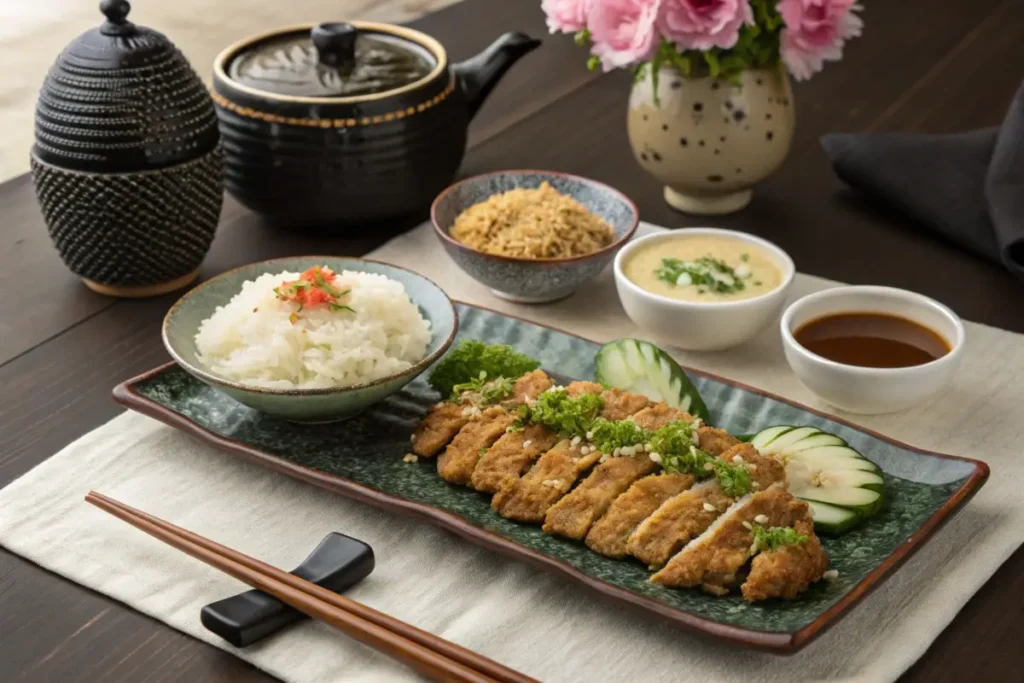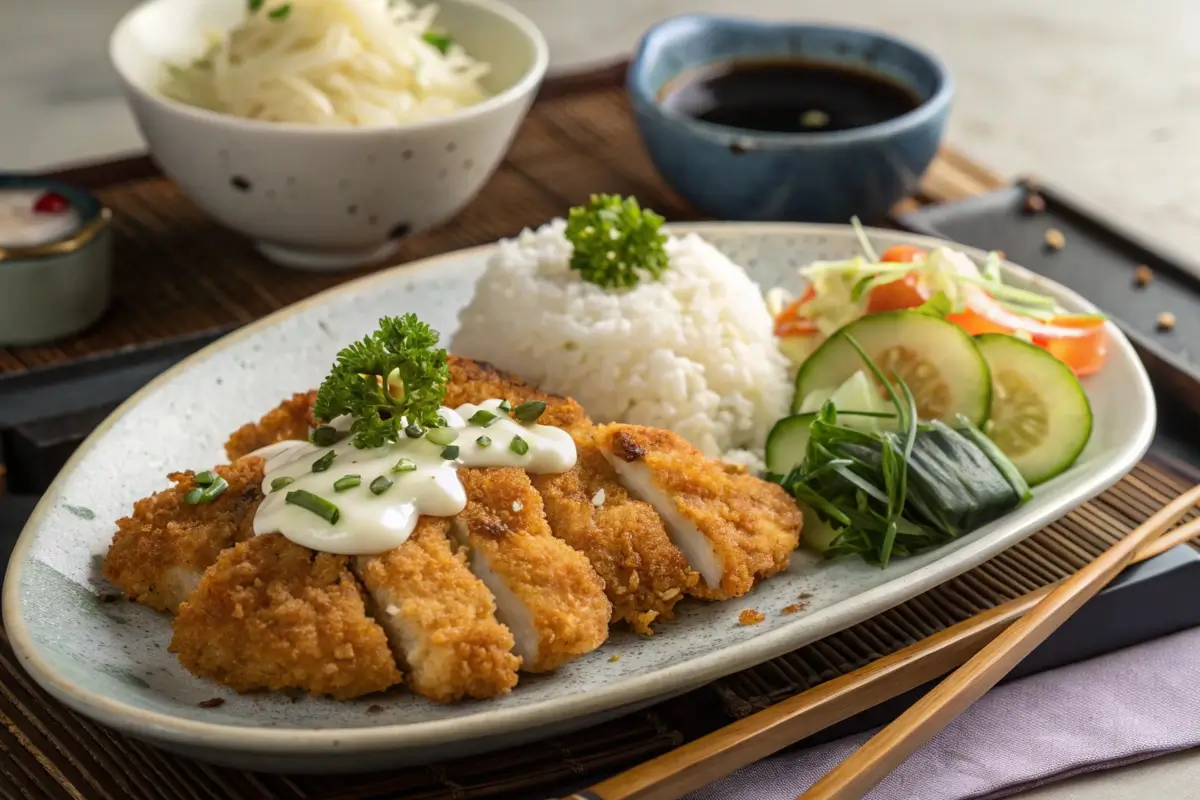Table of Contents
Japanese cuisine is a treasure trove of flavors, and Chicken Nanban stands out as a delightful fusion of sweet, sour, and savory tastes. Originating from Japan’s Miyazaki Prefecture, this dish features crispy fried chicken, soaked in a tangy nanban sauce, and topped with creamy tartar sauce. Whether you’re a seasoned foodie or new to Japanese cooking, this article will guide you through everything you need to know about Chicken Nanban—its origins, preparation, and variations. Let’s dive in!
What is Chicken Nanban?
At its core, Chicken Nanban is a dish of fried chicken coated in a flavorful blend of sweet and sour sauce known as nanban sauce. The dish is often topped with a rich tartar sauce, making it a deliciously indulgent meal. Its crispy texture and vibrant flavor profile make it a favorite in Japanese households and restaurants alike.
Origins and Historical Background
Chicken Nanban traces its roots to the Kyushu region of Japan, specifically Miyazaki Prefecture. The term “nanban” translates to “southern barbarian,” a nod to the Portuguese traders who introduced vinegar and frying techniques to Japan in the 16th century. Inspired by these foreign influences, Japanese chefs crafted a uniquely local dish, blending traditional flavors with a Western twist.
Cultural Significance in Japanese Cuisine
More than just a meal, Chicken Nanban embodies the creative evolution of Japanese cuisine. It represents yoshoku, or Western-inspired Japanese dishes, which gained popularity during the Meiji era. Today, it’s a beloved comfort food, often enjoyed with a side of steamed rice and pickles. The dish’s balance of flavors and textures also makes it a versatile option for casual dining and special occasions.
Ingredients Used in Chicken Nanban
For the Chicken:
- 500g chicken thighs (or chicken breasts, if preferred)
- 1/2 tsp salt
- 1/4 tsp black pepper
- 1/4 tsp garlic powder (optional)
- 1/2 cup all-purpose flour
- 2 large eggs (beaten)
- Vegetable oil (for frying)
For the Nanban Sauce:
- 1/4 cup rice vinegar
- 1/4 cup soy sauce
- 2 tbsp sugar
- 1 tbsp mirin (optional, for added sweetness)
- 1 tsp grated ginger (optional, for extra flavor)
For the Tartar Sauce:
- 1/2 tsp mustard (optional)
- 1/2 cup mayonnaise
- 2 hard-boiled eggs (chopped)
- 2 tbsp pickles (finely chopped)
- 1 tsp lemon juice
How to Make Chicken Nanban: Step-by-Step Guide
Preparing the Chicken for Frying
Start by slicing the chicken into bite-sized pieces to ensure even cooking. Season the pieces liberally with salt, pepper, and garlic powder, allowing the flavors to penetrate the meat. Prepare two bowls—one with all-purpose flour and the other with beaten eggs.

Dip each piece of chicken into the flour, ensuring a light coating, then immerse it in the egg mixture. This method guarantees a crispy, golden exterior. Heat a skillet with a generous amount of vegetable oil until it reaches the perfect frying temperature (around 350°F). Fry the chicken in batches to avoid overcrowding, cooking each piece for 4-5 minutes until it turns a deep golden brown.
Cooking the Perfect Nanban Sauce
While the chicken rests on a wire rack to drain excess oil, it’s time to create the star of the dish—the nanban sauce. Combine equal parts rice vinegar and soy sauce in a saucepan, then stir in sugar until it dissolves completely. For additional layers of flavor, add a splash of mirin and a teaspoon of grated ginger.
Heat the mixture over medium heat, stirring occasionally until it thickens slightly. Once ready, toss the fried chicken pieces into the warm nanban sauce, allowing them to soak up the tangy, umami-packed goodness.
Serving with Tartar Sauce
Plate the coated chicken and generously dollop tartar sauce over each piece. The creamy tartar not only balances the tanginess of the sauce but also adds a cooling element to the dish. For a complete meal, pair your Chicken Nanban with steamed rice and a fresh salad.
Want more ways to use similar techniques? Check out this cornflake chicken recipe for another crispy, flavorful alternative.
Variations of Chicken Nanban
Regional Twists in Japan
In Japan, Chicken Nanban has evolved into many delightful variations depending on the region. The most authentic style comes from Miyazaki Prefecture, where the dish first gained popularity. This traditional version emphasizes simplicity: crispy fried chicken paired with a perfectly balanced nanban sauce and homemade tartar sauce.
In contrast, some regions use karaage-style fried chicken for a lighter, crunchier texture. Other adaptations include swapping tartar sauce with a lighter yogurt-based dressing or adding a hint of local spices to the sauce. For a unique flair, Okinawan recipes often incorporate shikuwasa citrus juice, giving the dish a tangy tropical twist.
Modern Adaptations Around the World
As Chicken Nanban has gained international fame, chefs worldwide have put their own spin on it. Some popular modern variations include using panko breadcrumbs instead of traditional flour coatings for extra crunch. Others incorporate spicy elements like chili oil or sriracha into the tartar sauce to suit a bolder palate.
For health-conscious cooks, grilled or air-fried chicken provides a guilt-free option without compromising the essence of the dish. Vegetarian versions replace chicken with tofu or cauliflower, ensuring everyone can enjoy the magic of Chicken Nanban.
If you’re looking to expand your repertoire with more Asian-inspired chicken dishes, check out our chicken with lavender recipe for another flavorful option.
Tips and Tricks for Perfect Chicken Nanban
How to Avoid Common Mistakes
The key to flawless Chicken Nanban is mastering the balance between crispiness and flavor. First, always fry the chicken at the right temperature (around 350°F). Too low, and the coating absorbs oil, becoming greasy; too high, and it burns before the chicken cooks through.
When it comes to the nanban sauce, don’t let it sit for too long after making it. The sauce should be warm when coating the chicken to ensure even absorption. For tartar sauce, make it ahead of time to let the flavors meld beautifully.
Choosing the Best Ingredients
Using fresh, high-quality ingredients elevates your Chicken Nanban to the next level. Opt for free-range chicken for better flavor and texture. Choose authentic Japanese staples like rice vinegar, mirin, and soy sauce for a more traditional taste.
Homemade tartar sauce always outshines store-bought alternatives. Fresh mayonnaise, finely diced pickles, and boiled eggs are a must. For a citrusy kick, use freshly squeezed lemon juice instead of bottled.
Finally, pay attention to the sides. Simple accompaniments like steamed rice and lightly seasoned vegetables perfectly complement the bold flavors of Chicken Nanban. For more meal ideas, explore this steak bowl recipe for a satisfying side option.
Nutritional Insights and Serving Suggestions

Nutritional Profile of Chicken Nanban
Chicken Nanban is not just a flavor-packed dish; it also provides a balanced nutritional profile when prepared thoughtfully. The crispy fried chicken offers a hearty dose of protein, essential for energy and muscle repair. However, frying does increase the calorie count, so consider using air-frying or grilling for a lighter version.
The tangy nanban sauce is typically low in fat, but its sugar content can add up. Opt for natural sweeteners like honey or reduce the sugar for a healthier alternative. Meanwhile, the tartar sauce, rich in fats due to mayonnaise, can be lightened with Greek yogurt or low-fat mayo without sacrificing flavor.
Adding steamed rice and fresh vegetables as sides helps round out the dish nutritionally, providing fiber and additional vitamins. To make Chicken Nanban part of a balanced meal, portion control is key.
What to Pair it With
Serving Chicken Nanban with complementary dishes elevates the dining experience. Traditionally, it’s paired with a bowl of steamed white rice, which balances the tangy flavors of the sauce. A side of miso soup or lightly pickled vegetables provides an authentic Japanese touch.
For a modern twist, pair it with a crisp green salad or roasted sweet potatoes. The versatility of Chicken Nanban makes it a great option for casual dinners or special occasions. If you’re hosting a dinner party, consider exploring other Japanese-inspired dishes like shrimp bowl recipes for a varied spread.
Frequently Asked Questions
What makes Chicken Nanban different from Karaage?
While both dishes feature fried chicken, the key difference lies in their preparation and flavors. Karaage is seasoned and fried chicken served plain or with optional dips. Chicken Nanban, on the other hand, is dipped in a tangy nanban sauce and topped with tartar sauce, adding layers of flavor.
Can I make Chicken Nanban healthier?
Absolutely! Use an air fryer instead of deep-frying to cut down on oil. Replace full-fat tartar sauce with a lighter option like Greek yogurt mixed with lemon juice and herbs. Reducing sugar in the sauce is another simple tweak.
How to store leftovers?
Leftover Chicken Nanban can be stored in an airtight container in the refrigerator for up to three days. Reheat in an oven or air fryer to maintain crispiness. Avoid microwaving, as it may make the coating soggy.
What are the essential tools needed?
To make Chicken Nanban, you’ll need a frying pan or deep fryer, a wire rack for draining excess oil, and mixing bowls for the coatings and sauces. A food thermometer is helpful for ensuring perfect frying temperatures.
Conclusion:
Chicken Nanban is more than just a meal—it’s an experience. Combining the perfect balance of crispy textures, tangy sauces, and creamy toppings, this dish is a celebration of Japanese culinary creativity. Its rich history, rooted in Miyazaki Prefecture, adds depth and cultural significance, making it a must-try for anyone interested in Japanese cuisine.
What makes Chicken Nanban truly special is its versatility. Whether you prefer the traditional version or a modern twist, it’s a dish that adapts to personal tastes and dietary needs. From its bold flavors to its satisfying crunch, every bite is a reminder of why this dish has gained global appeal.
Don’t let the idea of frying or making homemade sauces intimidate you! With the tips and tricks shared in this guide, creating Chicken Nanban at home is easier than you think. So, gather your ingredients, fire up the stove, and enjoy the delicious journey of making this iconic Japanese dish.
If you’re hungry for more, check out our other Japanese-inspired recipes for fresh ideas. You’ll be amazed at how one recipe can inspire a world of flavor.

